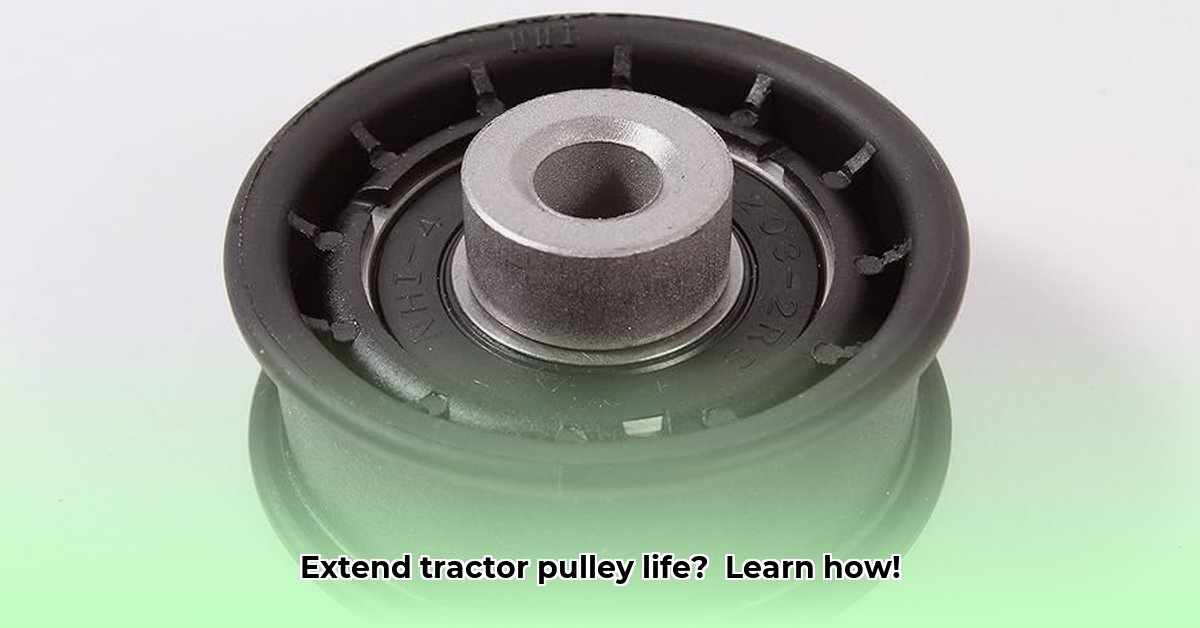
Understanding Pulley Types and Materials: Choosing the Right Material for Your Needs
Farm equipment relies heavily on pulleys for efficient power transmission. The longevity and performance of these components directly impact equipment lifespan, operational efficiency, and overall sustainability. Selecting the appropriate pulley material is the first crucial step in optimizing your equipment's performance and minimizing environmental impact. What's the most effective material for your specific application?
This section analyzes three common pulley materials: steel, aluminum, and composites. Each offers a unique blend of advantages and disadvantages in terms of durability, weight, cost, and environmental impact. Careful consideration of these factors is critical for responsible and cost-effective farm management.
| Material | Advantages | Disadvantages | Environmental Impact |
|---|---|---|---|
| Steel | Extremely strong and durable; ideal for heavy-duty applications; long lifespan | Heavy, increasing energy consumption; susceptible to rust; higher initial cost | Recycling is possible, though energy-intensive; manufacturing contributes significantly to carbon emissions. |
| Aluminum | Lightweight, reducing fuel consumption; excellent corrosion resistance; generally more affordable | Less robust than steel; may bend under extreme loads; potentially shorter lifespan | More easily recycled than steel; generally lower carbon footprint during manufacturing. |
| Composites | Lightweight yet strong; corrosion-resistant; potentially longer lifespan than aluminum | Can be more expensive than steel or aluminum; durability varies greatly depending on the specific composite and manufacturing process | Varies significantly depending on the specific materials used; some composites offer superior sustainability compared to others. Careful research into the material composition is essential. |
Figure 1: (Insert a bar chart comparing material properties—weight, strength, cost, and environmental impact—for steel, aluminum, and composite pulleys.)
Selecting the Perfect Pulley: A Step-by-Step Guide for Optimal Performance
Choosing the right pulley involves more than just visual similarity; precision is key. Improper selection can lead to premature wear, reduced efficiency, and potentially costly equipment failures. This section provides a step-by-step guide to ensure a perfect match for your specific equipment and application. Could improper pulley selection be costing you time and money?
Step 1: Consult Your Equipment Manual: Your equipment's manual provides the precise specifications (size, material, etc.) for optimal performance and compatibility. Ignoring these recommendations can void warranties and lead to premature failures.
Step 2: Thoroughly Inspect the Existing Pulley: Carefully examine the old pulley, noting the diameter, groove width, number of grooves, and any other relevant markings. Accurate measurements are crucial for selecting the correct replacement.
Step 3: Find a Precise Match at Your Local Tractor Supply: Head to your tractor supply store armed with precise measurements and specifications from your equipment manual. Choose a replacement pulley that exactly matches these specifications. Even minor discrepancies can negatively impact performance.
Step 4: Consider the Load and Application: Heavy-duty applications demand the strength of steel pulleys. Lighter applications may benefit from the lighter weight and potentially lower fuel consumption of aluminum pulleys.
Step 5: Verify Sheave Integrity: Carefully inspect the sheave (the grooved part of the pulley) for any damage such as cracks, wear, or imperfections that could compromise belt grip and performance.
Pulley Inspection and Maintenance: Preventing Problems Before They Arise
Proactive maintenance is crucial for maximizing the lifespan of your pulleys and preventing costly repairs. Regular inspections and appropriate lubrication significantly reduce the risk of premature failure. How often should you inspect your pulleys?
Visual Inspection (Monthly): Conduct a monthly visual inspection of all pulleys for cracks, excessive wear, corrosion, or any signs of damage. Addressing minor issues promptly prevents them from escalating into major problems.
Lubrication (As Needed): Keep moving parts adequately lubricated using the manufacturer's recommended grease or lubricant. Proper lubrication reduces friction and wear, extending the lifespan of the pulley and associated components.
Tightness Check (Regularly): Ensure that your pulleys are securely fastened to their shafts. A loose pulley can slip, leading to damage and potential equipment failure.
Sustainable Practices: Minimizing Environmental Impact Through Responsible Choices
Sustainable agriculture requires responsible choices at every stage, including equipment selection and disposal. This section explores environmentally conscious approaches to pulley selection and management. What environmentally friendly options are available for pulley disposal?
Responsible Sourcing: Prioritize manufacturers that prioritize sustainable practices, such as utilizing recycled materials or employing environmentally friendly production methods. Look for certifications or endorsements to verify these claims.
Proper Pulley Disposal: When a pulley reaches the end of its lifespan, recycle it whenever possible. Many scrap metal yards and recycling centers accept metal pulleys for reuse or recycling.
Material Selection: Consider the lifecycle environmental impact of different materials. While aluminum generally has a lower carbon footprint than steel during manufacturing, the longer lifespan of steel pulleys might offset this advantage in certain applications.
Case Study: The Benefits of Proper Pulley Maintenance
(Optional section: Include 1-2 concise case studies demonstrating how proper pulley maintenance has extended equipment life, reduced fuel consumption, and improved overall farm efficiency. Quantify the benefits whenever possible. For example: "Farm X saw a 15% reduction in fuel consumption after implementing a regular pulley maintenance program.")
By following these guidelines, farmers of all levels can enhance the lifespan of their equipment, optimize efficiency and contribute to more sustainable farming practices. Remember, even small actions can significantly impact both your farm’s bottom line and the environment.